
ASUS Zenbook 14 OLED Review: PC/Mac Comparison?

ASUS Zenbook 14 OLED Review: PC/Mac Comparison?
Key Takeaways
- The ASUS Zenbook 14 OLED (UX3405) is a high-performance, ultra-portable Windows laptop that matches the blend of performance, battery life, portability, and efficiency found in Apple’s MacBook series.
- The Zenbook 14 OLED features a stunning 14-inch OLED display, a slim and stylish design, and a new processor that provides significant performance and efficiency gains.
- While the webcam and speaker system have minor drawbacks, the Zenbook 14 OLED offers a comprehensive package that marks a significant milestone in productivity laptops, making it a compelling alternative to Apple’s MacBook series.
Since the introduction of Apple Silicon MacBooks back in late 2020, it’s fair to say there haven’t been any equivalent Windows laptops that can compete on performance, battery life, portability, and efficiency. While many laptops outcompeted the MacBooks in one of those four areas, nothing seemed to match the total benefits of Apple’s M-series Macs. The M2 MacBook Air series is one of the best-selling laptops for good reason.
Enter Asus’ Zenbook 14 OLED (UX3405), the company’s ultraportable productivity laptop with Intel’s new Core Ultra chipset. With its stunning display, low-profile design, and impressive battery life, the Zenbook 14 OLED offers the closest we’ve ever been to matching Apple’s MacBook Air.
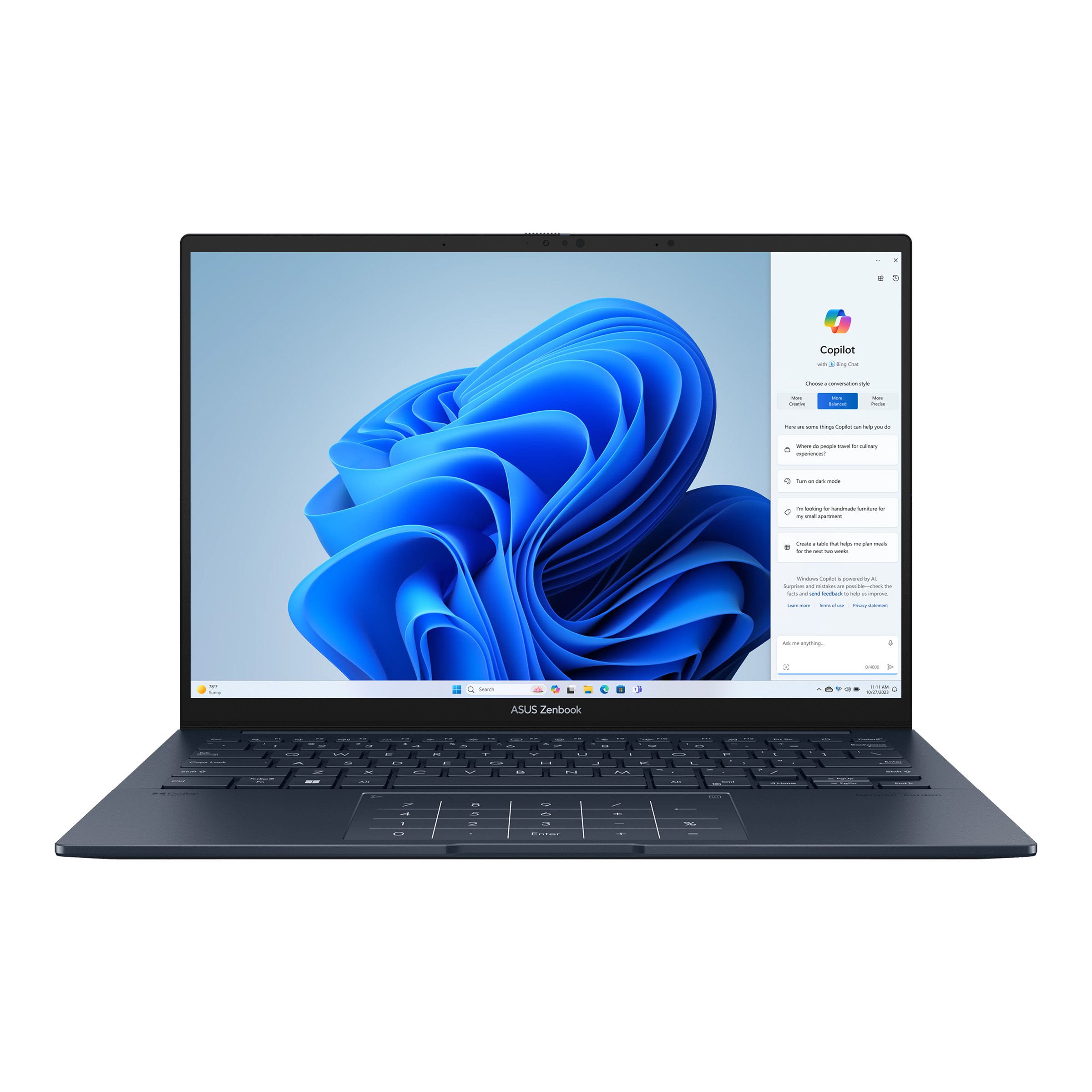

ASUS Zenbook 14 OLED (UX3405)
The MacBook of Windows
8/ 10
Since the debut of Apple Silicon MacBooks, the search for an equivalent Windows laptop that matches their blend of performance, battery life, portability, and efficiency has been unfulfilled until the introduction of Asus’ Zenbook 14 OLED. With the Intel Meteor Lake architecture, this laptop not only approaches but also surpasses the expectations set by thin Windows productivity laptops in many aspects.
Featuring a stunning 14-inch OLED display, a design that balances slimness with style, and a new processor that boasts significant performance and efficiency gains, the Zenbook 14 OLED is a compelling choice for those seeking a high-performance, ultraportable laptop. Despite minor drawbacks in its webcam and speaker system, it presents a comprehensive package that marks a significant milestone in productivity laptops.
Operating System
Windows 11
CPU
Intel Core Ultra 7 155H
GPU
Intel Arc Graphics
RAM
16GB LPDDR5
Storage
512 or 1TB M.2 NVMe PCIe 4.0 SSD
Battery
75Wh
Display (Size, Resolution)
14.0-inch, 3K (2880 x 1800) OLED, 16:10 aspect ratio, 120Hz refresh rate, 400nits, 500nits HDR peak brightness
Camera
FHD camera
Speakers
Harman Kardon speakers
Ports
1x USB 3.2 Gen 1, Type-A, 2x Thunderbolt 4, 1x HDMI 2.1, 1x 3.5mm Combo Audio Jack
Weight
1.28kg (2.82lbs)
Brand
ASUS
Model
UX3405
Pros
- Ultra slim profile
- Excellent display
- Great battery life
Cons
- Audible fans come on quite often
- Weak webcam
- Speakers get tinny at high volumes
A Familiar Chic Design
In terms of design, the Asus Zenbook 14 OLED (UX3405) is quite similar to its predecessor, but that’s not a bad thing. This laptop is incredibly well-built and lightweight with a surprisingly slim profile; it weighs only 1.2kg (2.65lbs) and has a side profile of less than 14.9mm (0.59 inches), making it extremely portable.
The laptop lid features a distinctive Asus Monogram, making the device look unique among other aluminum laptops, though it does pick up on fingerprints quite easily, especially in this darker Ponder Blue colorway.

Zarif Ali / MakeUseOf
A Display to Dazzle
Once you open up the laptop, you’re greeted with a sizable 14-inch OLED display, a full-sized keyboard, and a sizable trackpad. The Zenbook 14 boasts a 14-inch 3K Asus Lumina OLED touchscreen with a 120Hz refresh rate, and it is stunning; the display covers 100% DCI-P3 color gamut, supports HDR, and features a 1,000,000:1 contrast ratio.
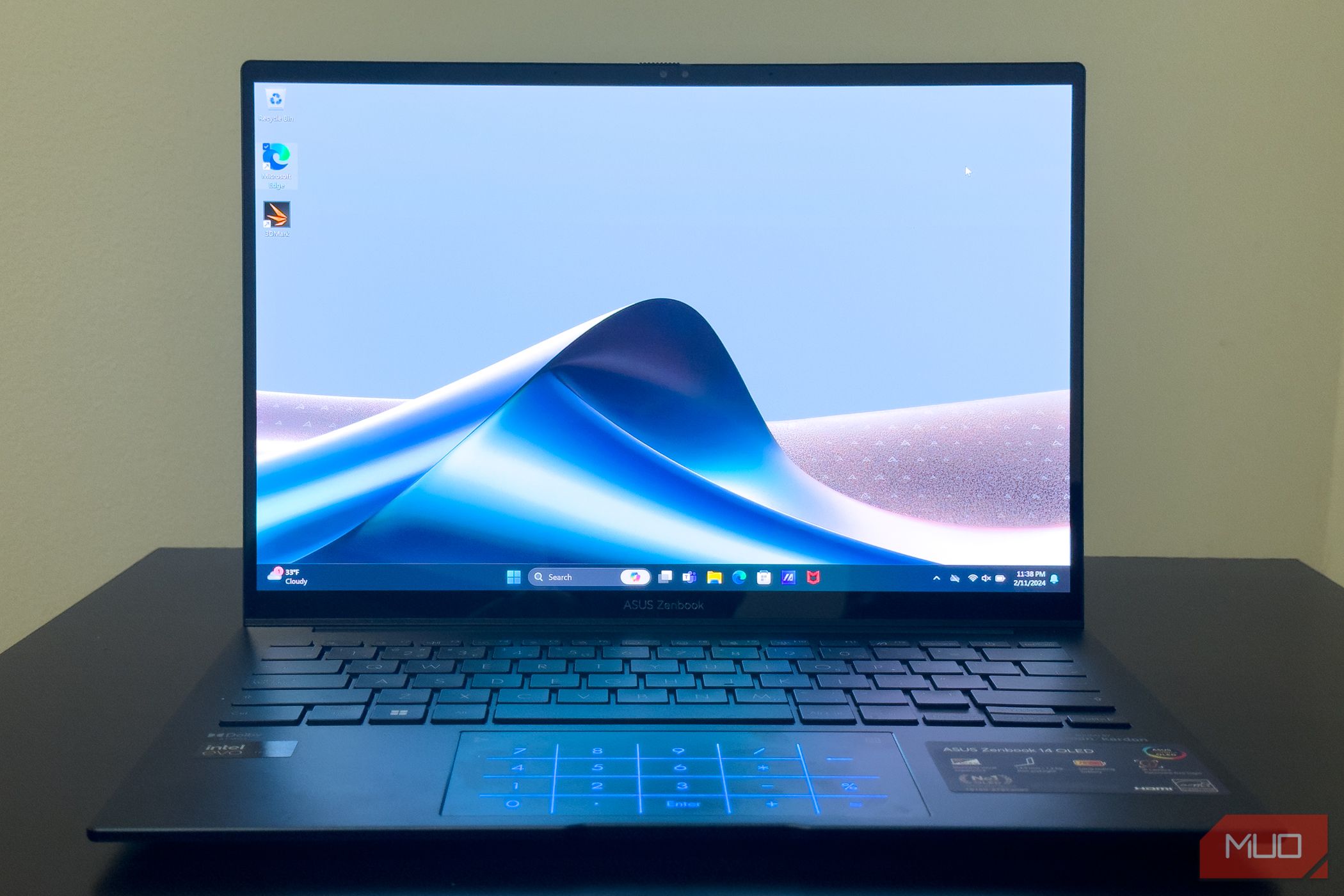
Zarif Ali / MakeUseOf
Asus opting for an OLED panel in its lineup once again yields what is arguably one of the best laptop displays you’ll find; the 16:10 aspect ratio is perfect for productivity apps like Word and PowerPoint but isn’t so tall that it obstructs content watching. It also helps that the bezels are very slim and don’t draw too much attention, though I wish the camera cover on the laptop was blacked out instead of being an orange hue, which can be distracting.
It is worth noting the display also has stylus support, but given it can only articulate to 180 degrees, and not the full 360 degrees, it won’t be as practical for pen input.
A Keyboard-Trackpad Combo That Won’t Disappoint
When it comes to the Zenbook 14’s keyboard and trackpad situation, the laptop offers an excellent experience. The full-sized chiclet keyboard with 1.4mm of travel distance is excellent in terms of key feel and is backlit, making it ideal for typing in various lighting conditions. That said, the keys feel slightly mushier than those of Microsoft or Apple’s offerings.
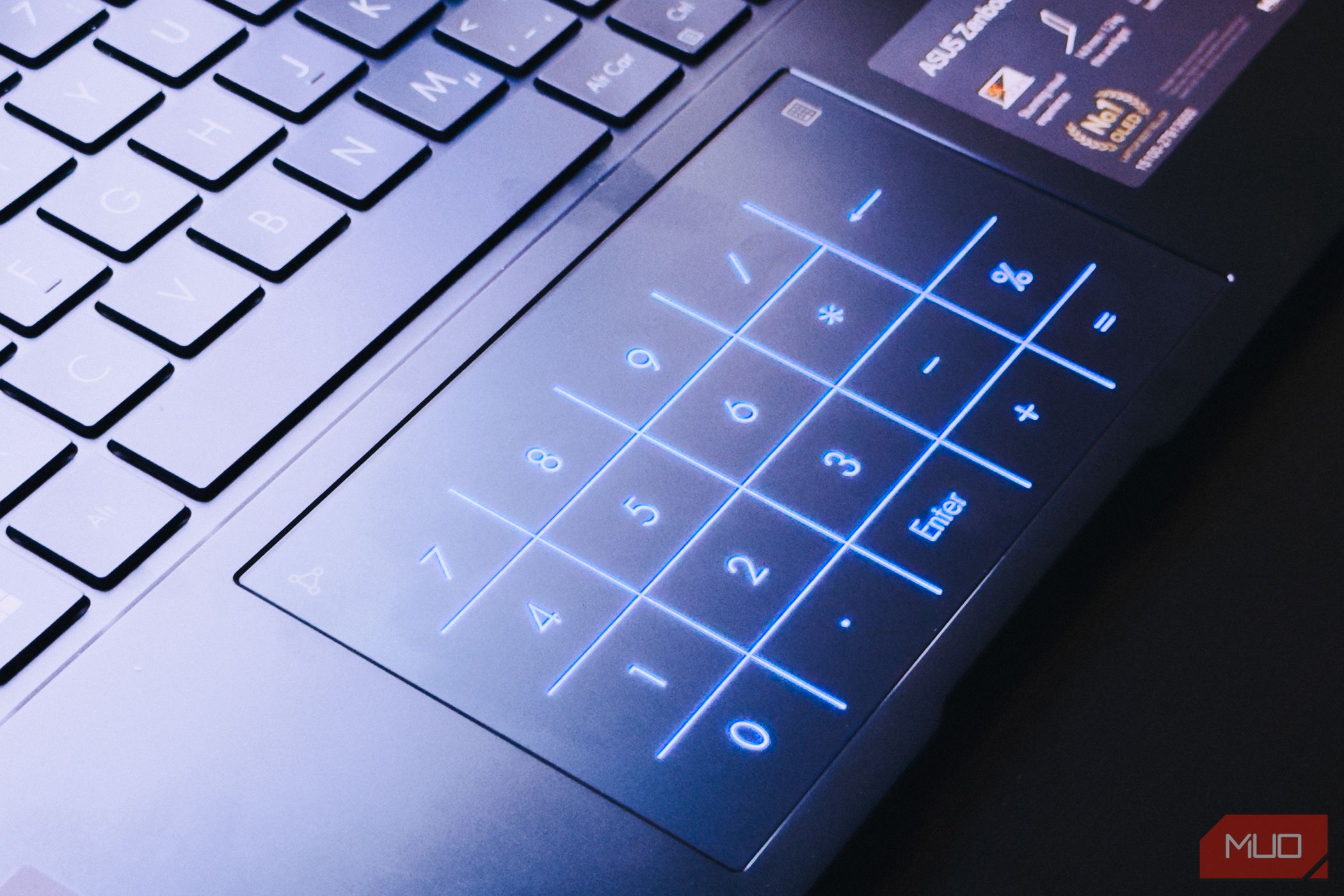
Zarif Ali / MakeUseOf
Like most other laptops in its category, to fit the full-sized keyboard, the Zenbook omits a number pad, but it makes up for it by incorporating a virtual one built into the trackpad. It’s not in the most natural position, and it doesn’t have the same tactility as a physical pad, but it’s there if you need a marginally faster way to type up your numbers.
Decent Port Selection
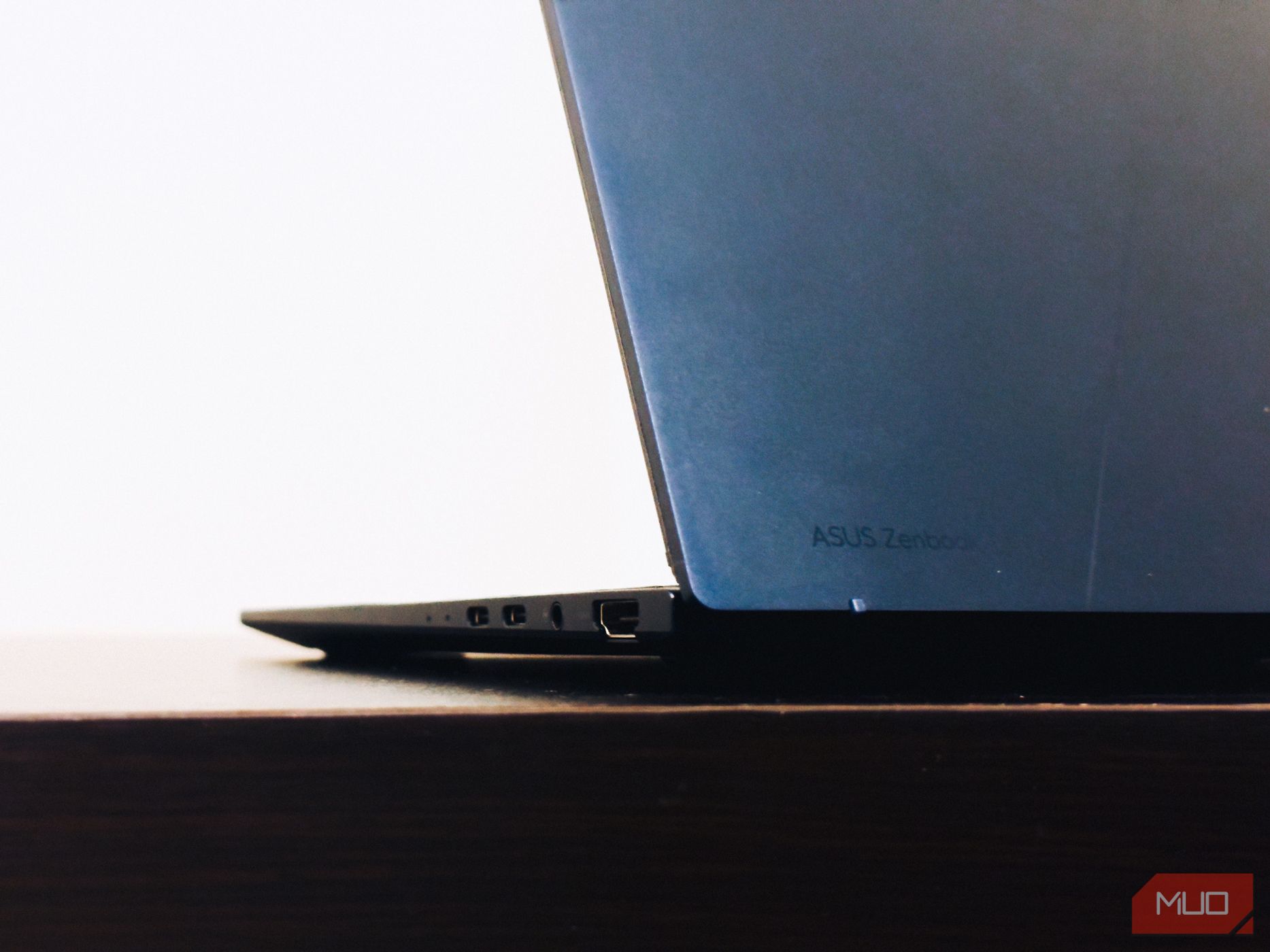
Zarif Ali / MakeUseOf
Moving to the sides of the Zenbook 14, it features a decent array of ports, including two Thunderbolt 4 (which both support display and power delivery), a full-size HDMI 2.1, one USB 3.2 Gen 1 Type-A, and an audio combo jack. Much like Asus’ other laptops, this blend of both legacy and speedy modern ports is great for this laptop’s versatility, especially in situations that require accessories or displays that might not be USB-C compatible.
A Webcam and Speaker System with Room For Improvement
The Zenbook 14 OLED’s webcam and speaker setup, much like other Asus laptops, leaves room for improvement. The laptop comes with a basic FHD webcam and IR function that supports Windows Hello, and the speakers are tuned by Harman Kardon.
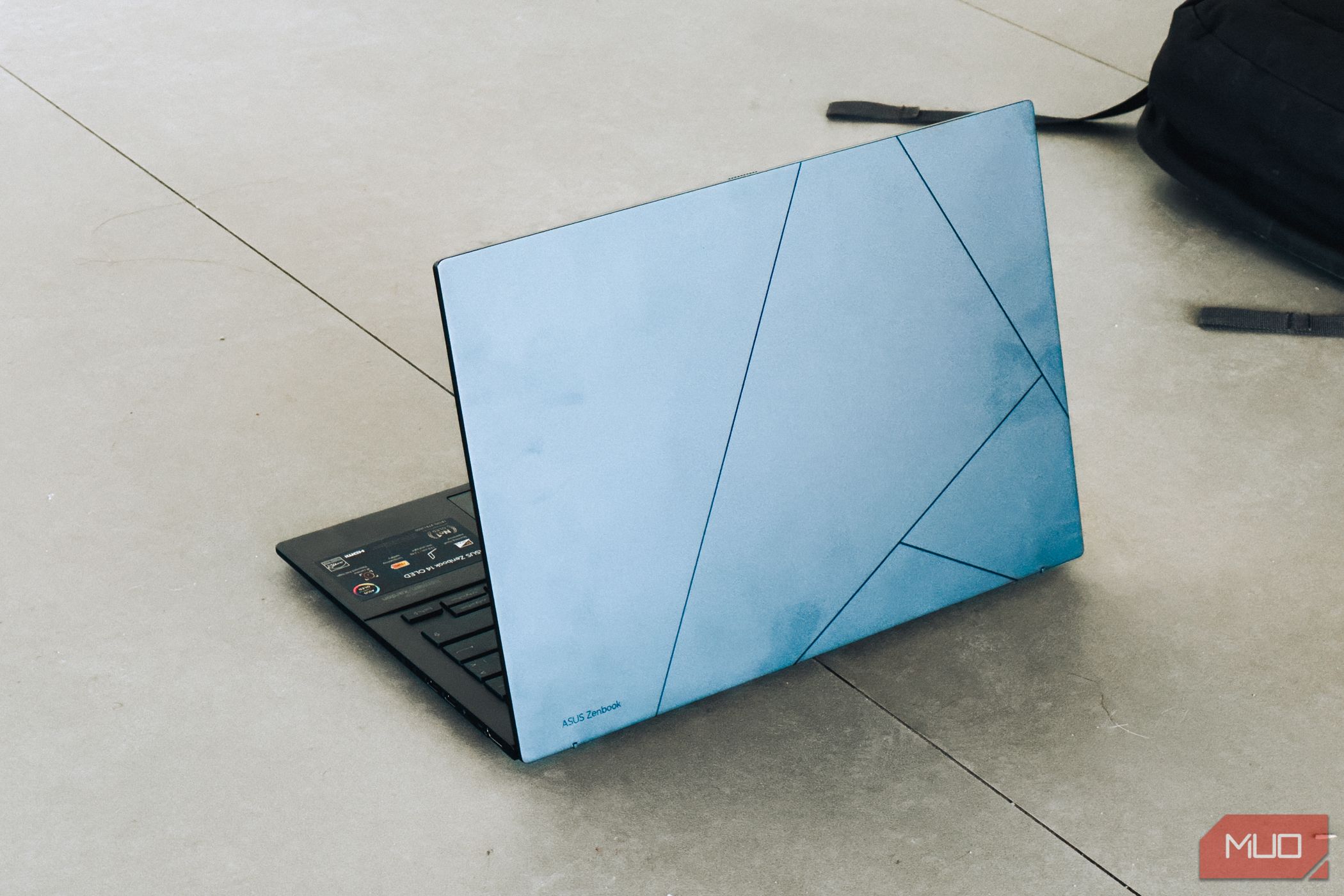
Zarif Ali / MakeUseOf
The webcam is supposedly powered by AI that offers on-device enhancements for faster login through facial scanning and “3D” noise reduction for video calls, but the quality of this camera is just ok; images look soft and grainy and quickly fall off with worsened lighting conditions.
Audio-wise, the laptop’s speakers sound clear at low to medium volumes, and pushing it higher results in a loss of clarity.
For general use, like watching videos, attending online meetings, or listening to music at moderate volumes, the Zenbook 14 OLED does the job. However, an external webcam might be necessary for tasks requiring high-quality audio or video. Overall, while the webcam and speakers are functional, these are areas where the Zenbook 14 OLED doesn’t lead the pack.
New Processor, New Performance Gains
The Zenbook 14 OLED’s biggest change this year is its processor, the new Intel Core Ultra 7-155H, part of Intel’s Core Ultra series based on the Intel Meteor Lake architecture. Our unit has 16 GB LPDDR5x memory and a 1TB PCIe 4.0 NVMe SSD; the results speak for themselves.

Zarif Ali / MakeUseOf
Intel’s Core Ultra 7 155H CPU marks a significant stride in performance, but more importantly, efficiency. Benchmarking this laptop on Geekbench 6 yielded scores of 2194 for single-core and 11,121 for multicore tasks. To put this into perspective, it is about the same as the baseline M3 14-inch MacBook Pro.
On 3DMark’s Time Spy, it achieved an overall score of 2,800, with the CPU scoring 3,049 and the GPU scoring 2,761. This should mean the Zenbook 14 can handle more graphically intensive tasks.
In practical use, these benchmarks mirror real-world performance. My experience with the Zenbook 14 OLED spanned a range of activities, including web browsing, multimedia consumption, coding on PyCharm, and photo editing on Adobe Photoshop and Lightroom. The laptop managed these tasks quite well, with very little stutter or lag. However, I will say software optimization still has a long way to go on the Windows side. The laptop can still get quite warm even with web browsing, and the fans kick in often and audibly.
That being said, battery life still gains a big advantage with this new chipset.
Surprisingly Good Battery Life
The Zenbook 14 OLED is equipped with a 75Wh battery, providing a quoted 15 hours of battery life. In actual usage, you’re going to average closer to nine hours of screen-on-time for everyday usage, which is quite good by the standards of most other Windows laptops in this form factor. The laptop also supports USB-C Easy Charge, and the included charger can charge the laptop in about an hour.

Zarif Ali / MakeUseOf
The only downside to the battery situation is the laptop will most certainly throttle its performance when not plugged in. Running the same GeekBench 6 benchmarks without being plugged in, the laptop scored 1,500 on single-core and 9,102 on multi-core, about a 32% drop in single-core performance and about 18% drop in multi-core performance. Will this translate to most real-world use? For gaming and content creation most definitely, but for more casual use cases like web browsing, you likely won’t experience it. That said, it’s a price to pay to achieve the laptop’s battery life in this form factor.
Overall, the ASUS Zenbook 14 OLED stands out as a high-performance ultraportable laptop. It not only meets but in many respects exceeds the expectations of these thin Windows productivity laptops. Whether it’s handling day-to-day tasks or more intensive computing demands, the Zenbook 14 OLED is quite reliable and efficient, and it’s a promising sign of how Intel’s new Meteor Lake architecture on Windows can compete with the likes of Apple Silicon and yield great results.
Should You Buy the ASUS Zenbook 14 OLED (UX3405)?
The Asus Zenbook 14 OLED feels like a different type of Windows laptop. Through a mixture of Intel’s latest Core Ultra chipset and the laptop’s very chic design, the Zenbook 14 OLED finely balances performance and battery life in a Windows package that doesn’t feel like it’s playing catch up to Apple’s MacBooks.
With its striking 14-inch OLED display, the Zenbook 14 offers a compromise-less experience in terms of media consumption and productivity. All the major tick-boxes you can think of are checked off, and performance-wise, the Zenbook 14 doesn’t tread lightly.
By performance, I mean that in combination with battery life, which, for the first time, feels like it isn’t an overlooked aspect of a thin-and-light Windows laptop. For students, this is one of the best laptops you can pick up that will adequately last you a full day on campus without really adding much bulk to your backpack.
That’s not to say it’s without its minor faults. The webcam and speaker system, while hardly a complete washout, are a little wanting when measured up against some of its competitors. However, it’s a small compromise in this larger picture of an excellent laptop.
All in all, the Zenbook 14 OLED feels like a Windows productivity laptop finally caught up to the Mac, and it’s in one very stylish package.

Key features:
• Import from any devices and cams, including GoPro and drones. All formats supported. Сurrently the only free video editor that allows users to export in a new H265/HEVC codec, something essential for those working with 4K and HD.
• Everything for hassle-free basic editing: cut, crop and merge files, add titles and favorite music
• Visual effects, advanced color correction and trendy Instagram-like filters
• All multimedia processing done from one app: video editing capabilities reinforced by a video converter, a screen capture, a video capture, a disc burner and a YouTube uploader
• Non-linear editing: edit several files with simultaneously
• Easy export to social networks: special profiles for YouTube, Facebook, Vimeo, Twitter and Instagram
• High quality export – no conversion quality loss, double export speed even of HD files due to hardware acceleration
• Stabilization tool will turn shaky or jittery footage into a more stable video automatically.
• Essential toolset for professional video editing: blending modes, Mask tool, advanced multiple-color Chroma Key
ASUS Zenbook 14 OLED (UX3405)
The MacBook of Windows
8/ 10
Since the debut of Apple Silicon MacBooks, the search for an equivalent Windows laptop that matches their blend of performance, battery life, portability, and efficiency has been unfulfilled until the introduction of Asus’ Zenbook 14 OLED. With the Intel Meteor Lake architecture, this laptop not only approaches but also surpasses the expectations set by thin Windows productivity laptops in many aspects.
Featuring a stunning 14-inch OLED display, a design that balances slimness with style, and a new processor that boasts significant performance and efficiency gains, the Zenbook 14 OLED is a compelling choice for those seeking a high-performance, ultraportable laptop. Despite minor drawbacks in its webcam and speaker system, it presents a comprehensive package that marks a significant milestone in productivity laptops.
Since the introduction of Apple Silicon MacBooks back in late 2020, it’s fair to say there haven’t been any equivalent Windows laptops that can compete on performance, battery life, portability, and efficiency. While many laptops outcompeted the MacBooks in one of those four areas, nothing seemed to match the total benefits of Apple’s M-series Macs. The M2 MacBook Air series is one of the best-selling laptops for good reason.
Enter Asus’ Zenbook 14 OLED (UX3405), the company’s ultraportable productivity laptop with Intel’s new Core Ultra chipset. With its stunning display, low-profile design, and impressive battery life, the Zenbook 14 OLED offers the closest we’ve ever been to matching Apple’s MacBook Air.


ASUS Zenbook 14 OLED (UX3405)
The MacBook of Windows
8/ 10
Since the debut of Apple Silicon MacBooks, the search for an equivalent Windows laptop that matches their blend of performance, battery life, portability, and efficiency has been unfulfilled until the introduction of Asus’ Zenbook 14 OLED. With the Intel Meteor Lake architecture, this laptop not only approaches but also surpasses the expectations set by thin Windows productivity laptops in many aspects.
Featuring a stunning 14-inch OLED display, a design that balances slimness with style, and a new processor that boasts significant performance and efficiency gains, the Zenbook 14 OLED is a compelling choice for those seeking a high-performance, ultraportable laptop. Despite minor drawbacks in its webcam and speaker system, it presents a comprehensive package that marks a significant milestone in productivity laptops.
Operating System
Windows 11
CPU
Intel Core Ultra 7 155H
GPU
Intel Arc Graphics
RAM
16GB LPDDR5
Storage
512 or 1TB M.2 NVMe PCIe 4.0 SSD
Battery
75Wh
Display (Size, Resolution)
14.0-inch, 3K (2880 x 1800) OLED, 16:10 aspect ratio, 120Hz refresh rate, 400nits, 500nits HDR peak brightness
Camera
FHD camera
Speakers
Harman Kardon speakers
Ports
1x USB 3.2 Gen 1, Type-A, 2x Thunderbolt 4, 1x HDMI 2.1, 1x 3.5mm Combo Audio Jack
Weight
1.28kg (2.82lbs)
Brand
ASUS
Model
UX3405
Pros
- Ultra slim profile
- Excellent display
- Great battery life
Cons
- Audible fans come on quite often
- Weak webcam
- Speakers get tinny at high volumes
A Familiar Chic Design
In terms of design, the Asus Zenbook 14 OLED (UX3405) is quite similar to its predecessor, but that’s not a bad thing. This laptop is incredibly well-built and lightweight with a surprisingly slim profile; it weighs only 1.2kg (2.65lbs) and has a side profile of less than 14.9mm (0.59 inches), making it extremely portable.
The laptop lid features a distinctive Asus Monogram, making the device look unique among other aluminum laptops, though it does pick up on fingerprints quite easily, especially in this darker Ponder Blue colorway.

Zarif Ali / MakeUseOf
A Display to Dazzle
Once you open up the laptop, you’re greeted with a sizable 14-inch OLED display, a full-sized keyboard, and a sizable trackpad. The Zenbook 14 boasts a 14-inch 3K Asus Lumina OLED touchscreen with a 120Hz refresh rate, and it is stunning; the display covers 100% DCI-P3 color gamut, supports HDR, and features a 1,000,000:1 contrast ratio.

Zarif Ali / MakeUseOf
Asus opting for an OLED panel in its lineup once again yields what is arguably one of the best laptop displays you’ll find; the 16:10 aspect ratio is perfect for productivity apps like Word and PowerPoint but isn’t so tall that it obstructs content watching. It also helps that the bezels are very slim and don’t draw too much attention, though I wish the camera cover on the laptop was blacked out instead of being an orange hue, which can be distracting.
It is worth noting the display also has stylus support, but given it can only articulate to 180 degrees, and not the full 360 degrees, it won’t be as practical for pen input.
A Keyboard-Trackpad Combo That Won’t Disappoint
When it comes to the Zenbook 14’s keyboard and trackpad situation, the laptop offers an excellent experience. The full-sized chiclet keyboard with 1.4mm of travel distance is excellent in terms of key feel and is backlit, making it ideal for typing in various lighting conditions. That said, the keys feel slightly mushier than those of Microsoft or Apple’s offerings.

Zarif Ali / MakeUseOf
Like most other laptops in its category, to fit the full-sized keyboard, the Zenbook omits a number pad, but it makes up for it by incorporating a virtual one built into the trackpad. It’s not in the most natural position, and it doesn’t have the same tactility as a physical pad, but it’s there if you need a marginally faster way to type up your numbers.
Decent Port Selection

Zarif Ali / MakeUseOf
Moving to the sides of the Zenbook 14, it features a decent array of ports, including two Thunderbolt 4 (which both support display and power delivery), a full-size HDMI 2.1, one USB 3.2 Gen 1 Type-A, and an audio combo jack. Much like Asus’ other laptops, this blend of both legacy and speedy modern ports is great for this laptop’s versatility, especially in situations that require accessories or displays that might not be USB-C compatible.
A Webcam and Speaker System with Room For Improvement
The Zenbook 14 OLED’s webcam and speaker setup, much like other Asus laptops, leaves room for improvement. The laptop comes with a basic FHD webcam and IR function that supports Windows Hello, and the speakers are tuned by Harman Kardon.

Zarif Ali / MakeUseOf
The webcam is supposedly powered by AI that offers on-device enhancements for faster login through facial scanning and “3D” noise reduction for video calls, but the quality of this camera is just ok; images look soft and grainy and quickly fall off with worsened lighting conditions.
Audio-wise, the laptop’s speakers sound clear at low to medium volumes, and pushing it higher results in a loss of clarity.
For general use, like watching videos, attending online meetings, or listening to music at moderate volumes, the Zenbook 14 OLED does the job. However, an external webcam might be necessary for tasks requiring high-quality audio or video. Overall, while the webcam and speakers are functional, these are areas where the Zenbook 14 OLED doesn’t lead the pack.
New Processor, New Performance Gains
The Zenbook 14 OLED’s biggest change this year is its processor, the new Intel Core Ultra 7-155H, part of Intel’s Core Ultra series based on the Intel Meteor Lake architecture. Our unit has 16 GB LPDDR5x memory and a 1TB PCIe 4.0 NVMe SSD; the results speak for themselves.

Zarif Ali / MakeUseOf
Intel’s Core Ultra 7 155H CPU marks a significant stride in performance, but more importantly, efficiency. Benchmarking this laptop on Geekbench 6 yielded scores of 2194 for single-core and 11,121 for multicore tasks. To put this into perspective, it is about the same as the baseline M3 14-inch MacBook Pro.
On 3DMark’s Time Spy, it achieved an overall score of 2,800, with the CPU scoring 3,049 and the GPU scoring 2,761. This should mean the Zenbook 14 can handle more graphically intensive tasks.
In practical use, these benchmarks mirror real-world performance. My experience with the Zenbook 14 OLED spanned a range of activities, including web browsing, multimedia consumption, coding on PyCharm, and photo editing on Adobe Photoshop and Lightroom. The laptop managed these tasks quite well, with very little stutter or lag. However, I will say software optimization still has a long way to go on the Windows side. The laptop can still get quite warm even with web browsing, and the fans kick in often and audibly.
That being said, battery life still gains a big advantage with this new chipset.
Surprisingly Good Battery Life
The Zenbook 14 OLED is equipped with a 75Wh battery, providing a quoted 15 hours of battery life. In actual usage, you’re going to average closer to nine hours of screen-on-time for everyday usage, which is quite good by the standards of most other Windows laptops in this form factor. The laptop also supports USB-C Easy Charge, and the included charger can charge the laptop in about an hour.

Zarif Ali / MakeUseOf
The only downside to the battery situation is the laptop will most certainly throttle its performance when not plugged in. Running the same GeekBench 6 benchmarks without being plugged in, the laptop scored 1,500 on single-core and 9,102 on multi-core, about a 32% drop in single-core performance and about 18% drop in multi-core performance. Will this translate to most real-world use? For gaming and content creation most definitely, but for more casual use cases like web browsing, you likely won’t experience it. That said, it’s a price to pay to achieve the laptop’s battery life in this form factor.
Overall, the ASUS Zenbook 14 OLED stands out as a high-performance ultraportable laptop. It not only meets but in many respects exceeds the expectations of these thin Windows productivity laptops. Whether it’s handling day-to-day tasks or more intensive computing demands, the Zenbook 14 OLED is quite reliable and efficient, and it’s a promising sign of how Intel’s new Meteor Lake architecture on Windows can compete with the likes of Apple Silicon and yield great results.
Should You Buy the ASUS Zenbook 14 OLED (UX3405)?
The Asus Zenbook 14 OLED feels like a different type of Windows laptop. Through a mixture of Intel’s latest Core Ultra chipset and the laptop’s very chic design, the Zenbook 14 OLED finely balances performance and battery life in a Windows package that doesn’t feel like it’s playing catch up to Apple’s MacBooks.
With its striking 14-inch OLED display, the Zenbook 14 offers a compromise-less experience in terms of media consumption and productivity. All the major tick-boxes you can think of are checked off, and performance-wise, the Zenbook 14 doesn’t tread lightly.
By performance, I mean that in combination with battery life, which, for the first time, feels like it isn’t an overlooked aspect of a thin-and-light Windows laptop. For students, this is one of the best laptops you can pick up that will adequately last you a full day on campus without really adding much bulk to your backpack.
That’s not to say it’s without its minor faults. The webcam and speaker system, while hardly a complete washout, are a little wanting when measured up against some of its competitors. However, it’s a small compromise in this larger picture of an excellent laptop.
All in all, the Zenbook 14 OLED feels like a Windows productivity laptop finally caught up to the Mac, and it’s in one very stylish package.

ASUS Zenbook 14 OLED (UX3405)
The MacBook of Windows
8/ 10
Since the debut of Apple Silicon MacBooks, the search for an equivalent Windows laptop that matches their blend of performance, battery life, portability, and efficiency has been unfulfilled until the introduction of Asus’ Zenbook 14 OLED. With the Intel Meteor Lake architecture, this laptop not only approaches but also surpasses the expectations set by thin Windows productivity laptops in many aspects.
Featuring a stunning 14-inch OLED display, a design that balances slimness with style, and a new processor that boasts significant performance and efficiency gains, the Zenbook 14 OLED is a compelling choice for those seeking a high-performance, ultraportable laptop. Despite minor drawbacks in its webcam and speaker system, it presents a comprehensive package that marks a significant milestone in productivity laptops.
Since the introduction of Apple Silicon MacBooks back in late 2020, it’s fair to say there haven’t been any equivalent Windows laptops that can compete on performance, battery life, portability, and efficiency. While many laptops outcompeted the MacBooks in one of those four areas, nothing seemed to match the total benefits of Apple’s M-series Macs. The M2 MacBook Air series is one of the best-selling laptops for good reason.
Enter Asus’ Zenbook 14 OLED (UX3405), the company’s ultraportable productivity laptop with Intel’s new Core Ultra chipset. With its stunning display, low-profile design, and impressive battery life, the Zenbook 14 OLED offers the closest we’ve ever been to matching Apple’s MacBook Air.


ASUS Zenbook 14 OLED (UX3405)
The MacBook of Windows
8/ 10
Since the debut of Apple Silicon MacBooks, the search for an equivalent Windows laptop that matches their blend of performance, battery life, portability, and efficiency has been unfulfilled until the introduction of Asus’ Zenbook 14 OLED. With the Intel Meteor Lake architecture, this laptop not only approaches but also surpasses the expectations set by thin Windows productivity laptops in many aspects.
Featuring a stunning 14-inch OLED display, a design that balances slimness with style, and a new processor that boasts significant performance and efficiency gains, the Zenbook 14 OLED is a compelling choice for those seeking a high-performance, ultraportable laptop. Despite minor drawbacks in its webcam and speaker system, it presents a comprehensive package that marks a significant milestone in productivity laptops.
Operating System
Windows 11
CPU
Intel Core Ultra 7 155H
GPU
Intel Arc Graphics
RAM
16GB LPDDR5
Storage
512 or 1TB M.2 NVMe PCIe 4.0 SSD
Battery
75Wh
Display (Size, Resolution)
14.0-inch, 3K (2880 x 1800) OLED, 16:10 aspect ratio, 120Hz refresh rate, 400nits, 500nits HDR peak brightness
Camera
FHD camera
Speakers
Harman Kardon speakers
Ports
1x USB 3.2 Gen 1, Type-A, 2x Thunderbolt 4, 1x HDMI 2.1, 1x 3.5mm Combo Audio Jack
Weight
1.28kg (2.82lbs)
Brand
ASUS
Model
UX3405
Pros
- Ultra slim profile
- Excellent display
- Great battery life
Cons
- Audible fans come on quite often
- Weak webcam
- Speakers get tinny at high volumes
A Familiar Chic Design
In terms of design, the Asus Zenbook 14 OLED (UX3405) is quite similar to its predecessor, but that’s not a bad thing. This laptop is incredibly well-built and lightweight with a surprisingly slim profile; it weighs only 1.2kg (2.65lbs) and has a side profile of less than 14.9mm (0.59 inches), making it extremely portable.
The laptop lid features a distinctive Asus Monogram, making the device look unique among other aluminum laptops, though it does pick up on fingerprints quite easily, especially in this darker Ponder Blue colorway.

 Easy and Safe Partition Software & Hard Disk Manager
Easy and Safe Partition Software & Hard Disk Manager
Zarif Ali / MakeUseOf
A Display to Dazzle
Once you open up the laptop, you’re greeted with a sizable 14-inch OLED display, a full-sized keyboard, and a sizable trackpad. The Zenbook 14 boasts a 14-inch 3K Asus Lumina OLED touchscreen with a 120Hz refresh rate, and it is stunning; the display covers 100% DCI-P3 color gamut, supports HDR, and features a 1,000,000:1 contrast ratio.

Zarif Ali / MakeUseOf
Asus opting for an OLED panel in its lineup once again yields what is arguably one of the best laptop displays you’ll find; the 16:10 aspect ratio is perfect for productivity apps like Word and PowerPoint but isn’t so tall that it obstructs content watching. It also helps that the bezels are very slim and don’t draw too much attention, though I wish the camera cover on the laptop was blacked out instead of being an orange hue, which can be distracting.
It is worth noting the display also has stylus support, but given it can only articulate to 180 degrees, and not the full 360 degrees, it won’t be as practical for pen input.
A Keyboard-Trackpad Combo That Won’t Disappoint
When it comes to the Zenbook 14’s keyboard and trackpad situation, the laptop offers an excellent experience. The full-sized chiclet keyboard with 1.4mm of travel distance is excellent in terms of key feel and is backlit, making it ideal for typing in various lighting conditions. That said, the keys feel slightly mushier than those of Microsoft or Apple’s offerings.

Zarif Ali / MakeUseOf
Like most other laptops in its category, to fit the full-sized keyboard, the Zenbook omits a number pad, but it makes up for it by incorporating a virtual one built into the trackpad. It’s not in the most natural position, and it doesn’t have the same tactility as a physical pad, but it’s there if you need a marginally faster way to type up your numbers.
Decent Port Selection

Zarif Ali / MakeUseOf
Moving to the sides of the Zenbook 14, it features a decent array of ports, including two Thunderbolt 4 (which both support display and power delivery), a full-size HDMI 2.1, one USB 3.2 Gen 1 Type-A, and an audio combo jack. Much like Asus’ other laptops, this blend of both legacy and speedy modern ports is great for this laptop’s versatility, especially in situations that require accessories or displays that might not be USB-C compatible.
A Webcam and Speaker System with Room For Improvement
The Zenbook 14 OLED’s webcam and speaker setup, much like other Asus laptops, leaves room for improvement. The laptop comes with a basic FHD webcam and IR function that supports Windows Hello, and the speakers are tuned by Harman Kardon.

Zarif Ali / MakeUseOf
The webcam is supposedly powered by AI that offers on-device enhancements for faster login through facial scanning and “3D” noise reduction for video calls, but the quality of this camera is just ok; images look soft and grainy and quickly fall off with worsened lighting conditions.
Audio-wise, the laptop’s speakers sound clear at low to medium volumes, and pushing it higher results in a loss of clarity.
For general use, like watching videos, attending online meetings, or listening to music at moderate volumes, the Zenbook 14 OLED does the job. However, an external webcam might be necessary for tasks requiring high-quality audio or video. Overall, while the webcam and speakers are functional, these are areas where the Zenbook 14 OLED doesn’t lead the pack.
New Processor, New Performance Gains
The Zenbook 14 OLED’s biggest change this year is its processor, the new Intel Core Ultra 7-155H, part of Intel’s Core Ultra series based on the Intel Meteor Lake architecture. Our unit has 16 GB LPDDR5x memory and a 1TB PCIe 4.0 NVMe SSD; the results speak for themselves.

Zarif Ali / MakeUseOf
Intel’s Core Ultra 7 155H CPU marks a significant stride in performance, but more importantly, efficiency. Benchmarking this laptop on Geekbench 6 yielded scores of 2194 for single-core and 11,121 for multicore tasks. To put this into perspective, it is about the same as the baseline M3 14-inch MacBook Pro.
On 3DMark’s Time Spy, it achieved an overall score of 2,800, with the CPU scoring 3,049 and the GPU scoring 2,761. This should mean the Zenbook 14 can handle more graphically intensive tasks.
In practical use, these benchmarks mirror real-world performance. My experience with the Zenbook 14 OLED spanned a range of activities, including web browsing, multimedia consumption, coding on PyCharm, and photo editing on Adobe Photoshop and Lightroom. The laptop managed these tasks quite well, with very little stutter or lag. However, I will say software optimization still has a long way to go on the Windows side. The laptop can still get quite warm even with web browsing, and the fans kick in often and audibly.
That being said, battery life still gains a big advantage with this new chipset.
Surprisingly Good Battery Life
The Zenbook 14 OLED is equipped with a 75Wh battery, providing a quoted 15 hours of battery life. In actual usage, you’re going to average closer to nine hours of screen-on-time for everyday usage, which is quite good by the standards of most other Windows laptops in this form factor. The laptop also supports USB-C Easy Charge, and the included charger can charge the laptop in about an hour.

Advanced Find and Replace for Google Sheets, Lifetime subscription
Zarif Ali / MakeUseOf
The only downside to the battery situation is the laptop will most certainly throttle its performance when not plugged in. Running the same GeekBench 6 benchmarks without being plugged in, the laptop scored 1,500 on single-core and 9,102 on multi-core, about a 32% drop in single-core performance and about 18% drop in multi-core performance. Will this translate to most real-world use? For gaming and content creation most definitely, but for more casual use cases like web browsing, you likely won’t experience it. That said, it’s a price to pay to achieve the laptop’s battery life in this form factor.
Overall, the ASUS Zenbook 14 OLED stands out as a high-performance ultraportable laptop. It not only meets but in many respects exceeds the expectations of these thin Windows productivity laptops. Whether it’s handling day-to-day tasks or more intensive computing demands, the Zenbook 14 OLED is quite reliable and efficient, and it’s a promising sign of how Intel’s new Meteor Lake architecture on Windows can compete with the likes of Apple Silicon and yield great results.
Should You Buy the ASUS Zenbook 14 OLED (UX3405)?
The Asus Zenbook 14 OLED feels like a different type of Windows laptop. Through a mixture of Intel’s latest Core Ultra chipset and the laptop’s very chic design, the Zenbook 14 OLED finely balances performance and battery life in a Windows package that doesn’t feel like it’s playing catch up to Apple’s MacBooks.
With its striking 14-inch OLED display, the Zenbook 14 offers a compromise-less experience in terms of media consumption and productivity. All the major tick-boxes you can think of are checked off, and performance-wise, the Zenbook 14 doesn’t tread lightly.
By performance, I mean that in combination with battery life, which, for the first time, feels like it isn’t an overlooked aspect of a thin-and-light Windows laptop. For students, this is one of the best laptops you can pick up that will adequately last you a full day on campus without really adding much bulk to your backpack.
That’s not to say it’s without its minor faults. The webcam and speaker system, while hardly a complete washout, are a little wanting when measured up against some of its competitors. However, it’s a small compromise in this larger picture of an excellent laptop.
All in all, the Zenbook 14 OLED feels like a Windows productivity laptop finally caught up to the Mac, and it’s in one very stylish package.

ASUS Zenbook 14 OLED (UX3405)
The MacBook of Windows
8/ 10
Since the debut of Apple Silicon MacBooks, the search for an equivalent Windows laptop that matches their blend of performance, battery life, portability, and efficiency has been unfulfilled until the introduction of Asus’ Zenbook 14 OLED. With the Intel Meteor Lake architecture, this laptop not only approaches but also surpasses the expectations set by thin Windows productivity laptops in many aspects.
Featuring a stunning 14-inch OLED display, a design that balances slimness with style, and a new processor that boasts significant performance and efficiency gains, the Zenbook 14 OLED is a compelling choice for those seeking a high-performance, ultraportable laptop. Despite minor drawbacks in its webcam and speaker system, it presents a comprehensive package that marks a significant milestone in productivity laptops.
Since the introduction of Apple Silicon MacBooks back in late 2020, it’s fair to say there haven’t been any equivalent Windows laptops that can compete on performance, battery life, portability, and efficiency. While many laptops outcompeted the MacBooks in one of those four areas, nothing seemed to match the total benefits of Apple’s M-series Macs. The M2 MacBook Air series is one of the best-selling laptops for good reason.
Enter Asus’ Zenbook 14 OLED (UX3405), the company’s ultraportable productivity laptop with Intel’s new Core Ultra chipset. With its stunning display, low-profile design, and impressive battery life, the Zenbook 14 OLED offers the closest we’ve ever been to matching Apple’s MacBook Air.


ASUS Zenbook 14 OLED (UX3405)
The MacBook of Windows
8/ 10
Since the debut of Apple Silicon MacBooks, the search for an equivalent Windows laptop that matches their blend of performance, battery life, portability, and efficiency has been unfulfilled until the introduction of Asus’ Zenbook 14 OLED. With the Intel Meteor Lake architecture, this laptop not only approaches but also surpasses the expectations set by thin Windows productivity laptops in many aspects.
Featuring a stunning 14-inch OLED display, a design that balances slimness with style, and a new processor that boasts significant performance and efficiency gains, the Zenbook 14 OLED is a compelling choice for those seeking a high-performance, ultraportable laptop. Despite minor drawbacks in its webcam and speaker system, it presents a comprehensive package that marks a significant milestone in productivity laptops.
Operating System
Windows 11
CPU
Intel Core Ultra 7 155H
GPU
Intel Arc Graphics
RAM
16GB LPDDR5
Storage
512 or 1TB M.2 NVMe PCIe 4.0 SSD
Battery
75Wh
Display (Size, Resolution)
14.0-inch, 3K (2880 x 1800) OLED, 16:10 aspect ratio, 120Hz refresh rate, 400nits, 500nits HDR peak brightness
Camera
FHD camera
Speakers
Harman Kardon speakers
Ports
1x USB 3.2 Gen 1, Type-A, 2x Thunderbolt 4, 1x HDMI 2.1, 1x 3.5mm Combo Audio Jack
Weight
1.28kg (2.82lbs)
Brand
ASUS
Model
UX3405
Pros
- Ultra slim profile
- Excellent display
- Great battery life
Cons
- Audible fans come on quite often
- Weak webcam
- Speakers get tinny at high volumes
A Familiar Chic Design
In terms of design, the Asus Zenbook 14 OLED (UX3405) is quite similar to its predecessor, but that’s not a bad thing. This laptop is incredibly well-built and lightweight with a surprisingly slim profile; it weighs only 1.2kg (2.65lbs) and has a side profile of less than 14.9mm (0.59 inches), making it extremely portable.
The laptop lid features a distinctive Asus Monogram, making the device look unique among other aluminum laptops, though it does pick up on fingerprints quite easily, especially in this darker Ponder Blue colorway.

Zarif Ali / MakeUseOf
A Display to Dazzle
Once you open up the laptop, you’re greeted with a sizable 14-inch OLED display, a full-sized keyboard, and a sizable trackpad. The Zenbook 14 boasts a 14-inch 3K Asus Lumina OLED touchscreen with a 120Hz refresh rate, and it is stunning; the display covers 100% DCI-P3 color gamut, supports HDR, and features a 1,000,000:1 contrast ratio.

Zarif Ali / MakeUseOf
Asus opting for an OLED panel in its lineup once again yields what is arguably one of the best laptop displays you’ll find; the 16:10 aspect ratio is perfect for productivity apps like Word and PowerPoint but isn’t so tall that it obstructs content watching. It also helps that the bezels are very slim and don’t draw too much attention, though I wish the camera cover on the laptop was blacked out instead of being an orange hue, which can be distracting.
It is worth noting the display also has stylus support, but given it can only articulate to 180 degrees, and not the full 360 degrees, it won’t be as practical for pen input.
### A Keyboard-Trackpad Combo That Won’t DisappointWhen it comes to the Zenbook 14’s keyboard and trackpad situation, the laptop offers an excellent experience. The full-sized chiclet keyboard with 1.4mm of travel distance is excellent in terms of key feel and is backlit, making it ideal for typing in various lighting conditions. That said, the keys feel slightly mushier than those of Microsoft or Apple’s offerings.

Zarif Ali / MakeUseOf
Like most other laptops in its category, to fit the full-sized keyboard, the Zenbook omits a number pad, but it makes up for it by incorporating a virtual one built into the trackpad. It’s not in the most natural position, and it doesn’t have the same tactility as a physical pad, but it’s there if you need a marginally faster way to type up your numbers.
Decent Port Selection

Zarif Ali / MakeUseOf
Moving to the sides of the Zenbook 14, it features a decent array of ports, including two Thunderbolt 4 (which both support display and power delivery), a full-size HDMI 2.1, one USB 3.2 Gen 1 Type-A, and an audio combo jack. Much like Asus’ other laptops, this blend of both legacy and speedy modern ports is great for this laptop’s versatility, especially in situations that require accessories or displays that might not be USB-C compatible.
A Webcam and Speaker System with Room For Improvement
The Zenbook 14 OLED’s webcam and speaker setup, much like other Asus laptops, leaves room for improvement. The laptop comes with a basic FHD webcam and IR function that supports Windows Hello, and the speakers are tuned by Harman Kardon.

Zarif Ali / MakeUseOf
The webcam is supposedly powered by AI that offers on-device enhancements for faster login through facial scanning and “3D” noise reduction for video calls, but the quality of this camera is just ok; images look soft and grainy and quickly fall off with worsened lighting conditions.
Audio-wise, the laptop’s speakers sound clear at low to medium volumes, and pushing it higher results in a loss of clarity.
For general use, like watching videos, attending online meetings, or listening to music at moderate volumes, the Zenbook 14 OLED does the job. However, an external webcam might be necessary for tasks requiring high-quality audio or video. Overall, while the webcam and speakers are functional, these are areas where the Zenbook 14 OLED doesn’t lead the pack.
New Processor, New Performance Gains
The Zenbook 14 OLED’s biggest change this year is its processor, the new Intel Core Ultra 7-155H, part of Intel’s Core Ultra series based on the Intel Meteor Lake architecture. Our unit has 16 GB LPDDR5x memory and a 1TB PCIe 4.0 NVMe SSD; the results speak for themselves.

Zarif Ali / MakeUseOf
Intel’s Core Ultra 7 155H CPU marks a significant stride in performance, but more importantly, efficiency. Benchmarking this laptop on Geekbench 6 yielded scores of 2194 for single-core and 11,121 for multicore tasks. To put this into perspective, it is about the same as the baseline M3 14-inch MacBook Pro.
On 3DMark’s Time Spy, it achieved an overall score of 2,800, with the CPU scoring 3,049 and the GPU scoring 2,761. This should mean the Zenbook 14 can handle more graphically intensive tasks.
In practical use, these benchmarks mirror real-world performance. My experience with the Zenbook 14 OLED spanned a range of activities, including web browsing, multimedia consumption, coding on PyCharm, and photo editing on Adobe Photoshop and Lightroom. The laptop managed these tasks quite well, with very little stutter or lag. However, I will say software optimization still has a long way to go on the Windows side. The laptop can still get quite warm even with web browsing, and the fans kick in often and audibly.
That being said, battery life still gains a big advantage with this new chipset.
Surprisingly Good Battery Life
The Zenbook 14 OLED is equipped with a 75Wh battery, providing a quoted 15 hours of battery life. In actual usage, you’re going to average closer to nine hours of screen-on-time for everyday usage, which is quite good by the standards of most other Windows laptops in this form factor. The laptop also supports USB-C Easy Charge, and the included charger can charge the laptop in about an hour.

Zarif Ali / MakeUseOf
The only downside to the battery situation is the laptop will most certainly throttle its performance when not plugged in. Running the same GeekBench 6 benchmarks without being plugged in, the laptop scored 1,500 on single-core and 9,102 on multi-core, about a 32% drop in single-core performance and about 18% drop in multi-core performance. Will this translate to most real-world use? For gaming and content creation most definitely, but for more casual use cases like web browsing, you likely won’t experience it. That said, it’s a price to pay to achieve the laptop’s battery life in this form factor.
Overall, the ASUS Zenbook 14 OLED stands out as a high-performance ultraportable laptop. It not only meets but in many respects exceeds the expectations of these thin Windows productivity laptops. Whether it’s handling day-to-day tasks or more intensive computing demands, the Zenbook 14 OLED is quite reliable and efficient, and it’s a promising sign of how Intel’s new Meteor Lake architecture on Windows can compete with the likes of Apple Silicon and yield great results.
Should You Buy the ASUS Zenbook 14 OLED (UX3405)?
The Asus Zenbook 14 OLED feels like a different type of Windows laptop. Through a mixture of Intel’s latest Core Ultra chipset and the laptop’s very chic design, the Zenbook 14 OLED finely balances performance and battery life in a Windows package that doesn’t feel like it’s playing catch up to Apple’s MacBooks.
With its striking 14-inch OLED display, the Zenbook 14 offers a compromise-less experience in terms of media consumption and productivity. All the major tick-boxes you can think of are checked off, and performance-wise, the Zenbook 14 doesn’t tread lightly.
By performance, I mean that in combination with battery life, which, for the first time, feels like it isn’t an overlooked aspect of a thin-and-light Windows laptop. For students, this is one of the best laptops you can pick up that will adequately last you a full day on campus without really adding much bulk to your backpack.
That’s not to say it’s without its minor faults. The webcam and speaker system, while hardly a complete washout, are a little wanting when measured up against some of its competitors. However, it’s a small compromise in this larger picture of an excellent laptop.
All in all, the Zenbook 14 OLED feels like a Windows productivity laptop finally caught up to the Mac, and it’s in one very stylish package.

 NeoDownloader - Fast and fully automatic image/video/music downloader.
NeoDownloader - Fast and fully automatic image/video/music downloader.
ASUS Zenbook 14 OLED (UX3405)
The MacBook of Windows
8/ 10
Since the debut of Apple Silicon MacBooks, the search for an equivalent Windows laptop that matches their blend of performance, battery life, portability, and efficiency has been unfulfilled until the introduction of Asus’ Zenbook 14 OLED. With the Intel Meteor Lake architecture, this laptop not only approaches but also surpasses the expectations set by thin Windows productivity laptops in many aspects.
Featuring a stunning 14-inch OLED display, a design that balances slimness with style, and a new processor that boasts significant performance and efficiency gains, the Zenbook 14 OLED is a compelling choice for those seeking a high-performance, ultraportable laptop. Despite minor drawbacks in its webcam and speaker system, it presents a comprehensive package that marks a significant milestone in productivity laptops.
- Title: ASUS Zenbook 14 OLED Review: PC/Mac Comparison?
- Author: Richard
- Created at : 2024-08-16 02:21:11
- Updated at : 2024-08-17 02:21:11
- Link: https://win11-tips.techidaily.com/asus-zenbook-14-oled-review-pcmac-comparison/
- License: This work is licensed under CC BY-NC-SA 4.0.


 With Screensaver Wonder you can easily make a screensaver from your own pictures and video files. Create screensavers for your own computer or create standalone, self-installing screensavers for easy sharing with your friends. Together with its sister product Screensaver Factory, Screensaver Wonder is one of the most popular screensaver software products in the world, helping thousands of users decorate their computer screens quickly and easily.
With Screensaver Wonder you can easily make a screensaver from your own pictures and video files. Create screensavers for your own computer or create standalone, self-installing screensavers for easy sharing with your friends. Together with its sister product Screensaver Factory, Screensaver Wonder is one of the most popular screensaver software products in the world, helping thousands of users decorate their computer screens quickly and easily.




 Jutoh is an ebook creator for Epub, Kindle and more. It’s fast, runs on Windows, Mac, and Linux, comes with a cover design editor, and allows book variations to be created with alternate text, style sheets and cover designs.
Jutoh is an ebook creator for Epub, Kindle and more. It’s fast, runs on Windows, Mac, and Linux, comes with a cover design editor, and allows book variations to be created with alternate text, style sheets and cover designs. 

.png) Kanto Player Professional
Kanto Player Professional

 CalendarBudget - Monthly subscription membership to CalendarBudget via web browser or mobile app. Support included.
CalendarBudget - Monthly subscription membership to CalendarBudget via web browser or mobile app. Support included. 